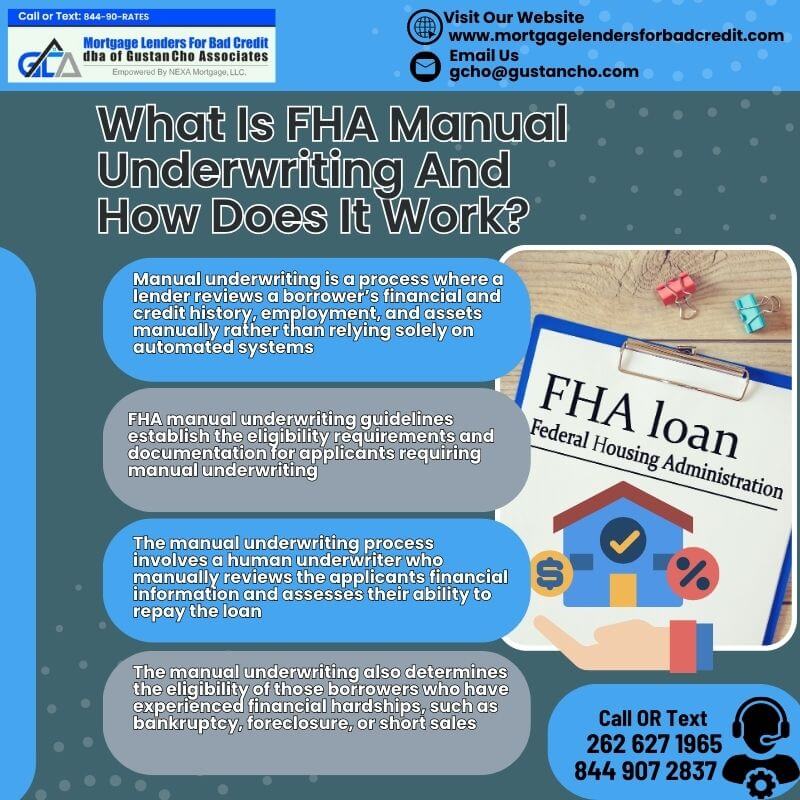FHA Manual Underwriting Mortgage Guidelines
In this guide, we will cover how FHA Manual Underwriting works. The Federal Housing Administration (FHA) provides various mortgage products to help Americans become homeowners. While many of these loans are subject to automatic underwriting, some applicants may require manual underwriting due to specific circumstances or challenges.
FHA Manual Underwriting Mortgage Guidelines provide a framework for determining whether an applicant is eligible for a mortgage through manual underwriting process on FHA loans.
This article will provide an overview of FHA Manual Underwriting Mortgage Guidelines, including eligibility requirements, required documentation, and tips for a successful underwriting process. By understanding the manual underwriting process, applicants can better prepare and navigate the path to homeownership.

What Is FHA Manual Underwriting

HUD, the parent of FHA, offers a range of mortgage products to help Americans become homeowners. The types of mortgage loan options HUD offers include FHA-insured loans subject to automatic underwriting system approval and manual underwriting.
Automated Underwriting System approval involves the use of a computer program to assess the borrowers eligibility. However, in certain situations, manual underwriting may be required to determine eligibility. FHA Manual Underwriting Mortgage Guidelines provide a framework for the manual underwriting process.
FHA manual underwriting mortgage process can be more time-consuming and labor-intensive than automatic underwriting. Still, it is essential for borrowers with unique circumstances requiring further review. Manual underwriting can be critical in certain situations, such as when an applicant has a low credit score, limited credit history, or inconsistent income.

What Is FHA Manual Underwriting and how does it Work
Manual underwriting is a process where a lender reviews a borrower’s financial and credit history, employment, and assets manually rather than relying solely on automated systems. FHA Manual Underwriting Mortgage Guidelines establish the framework for determining when a borrower is eligible for manual underwriting and what documentation and requirements are needed to complete the process.
FHA manual underwriting guidelines establish the eligibility requirements and documentation for applicants requiring manual underwriting. The manual underwriting process involves a human underwriter who manually reviews the applicants financial information and assesses their ability to repay the loan.
To be eligible for manual underwriting, borrowers must meet certain criteria, such as having a credit score below the minimum required for automatic underwriting. They may also have limited credit history or non-traditional sources of income, such as self-employment or irregular payment schedules. Borrowers who have experienced financial hardships, such as bankruptcy, foreclosure, or short sales, may also require manual underwriting to determine their eligibility.
When Is FHA Manual Underwriting Required
Circumstances that require manual underwriting include situations where the borrower has a low credit score, high debt-to-income ratio, or other factors that automated underwriting systems cannot evaluate. This can include borrowers who have been self-employed for less than two years or those with a gap in employment history.
Under the FHA Manual Underwriting Mortgage Guidelines, borrowers must provide extensive documentation to support their eligibility for manual underwriting. This documentation can include employment and income verification, payment history, rent or mortgage payment history, and any other financial records that demonstrate creditworthiness.
Overall, the FHA Manual Underwriting Mortgage Guidelines provide a pathway to homeownership for those who may not qualify for a loan through automatic underwriting. The process requires additional documentation and review, but it can be an invaluable tool for borrowers who might not otherwise be able to obtain a mortgage loan.

Requirements for FHA Manual Underwriting
The FHA Manual Underwriting Mortgage Guidelines have specific requirements for borrowers seeking manual underwriting. FHA manual underwriting requirements cover various aspects of the borrower’s financial profile, including credit score, debt-to-income ratio, employment and income verification, and payment history. Credit score requirements.
FHA manual underwriting guidelines outline the requirements for documentation, eligibility, and creditworthiness that must be met for a successful manual underwriting process on FHA loans.
Borrowers who seek manual underwriting typically have a credit score below the minimum required for automatic underwriting. Under the FHA Manual Underwriting Mortgage Guidelines, the minimum credit score for manual underwriting is 500. However, lenders may have minimum credit score requirements that are
higher than this.
FHA Manual Underwriting Debt-to-income Ratio Guidelines

The debt-to-income ratio (DTI) measures the borrowers’ monthly debt payments as a percentage of their monthly income. Under the FHA Manual Underwriting Mortgage Guidelines, the maximum DTI for manual underwriting depends on the number of compensating factors.
Some lenders may have more stringent requirements. Borrowers must provide documentation of all their debts, including credit cards, car loans, student loans, and income. Employment and income verification: To be eligible for manual underwriting, borrowers must provide employment and income documentation.
There are income and other documents that borrowers need during the mortgage process. Mortgage documents required include recent pay stubs, W-2 forms, and tax returns. Self-employed borrowers must provide additional documentation, such as profit and loss statements and business tax returns. Lenders may also contact employers directly to verify employment status.
FHA Manual Underwriting Guidelines on Payment History
Borrowers seeking manual underwriting must demonstrate a consistent history of on-time payments. This includes rent or mortgage payments and other bills such as utilities and credit cards. Lenders may require payment histories covering up to 24 months.
Borrowers who have experienced financial hardship in the past, such as bankruptcy or foreclosure, must provide documentation of the event and demonstrate that they have recovered financially. Overall, the FHA Manual Underwriting Mortgage Guidelines require extensive documentation to support the borrowers eligibility for manual underwriting.
Borrowers must provide evidence of their creditworthiness, income, employment, and payment history. The process can be time-consuming and complex, but it provides a path to homeownership for those who may not qualify for a loan through automated underwriting.
Documentation Required for FHA Manual Underwriting
The documentation required for FHA manual underwriting is extensive and is meant to provide a detailed picture of the borrower's financial situation. Below are some of the key documents required
Manual underwriting allows lenders to review each borrower’s unique situation in detail and make an informed decision based on their financial history, employment, and other factors affecting their ability to repay the loan. By providing additional oversight and scrutiny, manual underwriting can reduce the risk of defaults and foreclosures, making it a valuable tool for lenders and borrowers.
Income and employment verification documents: To prove their ability to repay the loan, borrowers must provide proof of their employment and income. This can include recent pay stubs, W-2 forms, and tax returns. Self-employed borrowers must provide additional documentation, such as profit and loss statements and business tax returns. Lenders may also contact employers directly to verify employment status.

Importance of Compensating Factors on Manual Underwriting
Besides income, borrowers must provide documentation of their assets and savings, such as bank statements, investment account statements, and retirement account statements. This helps lenders evaluate borrowers’ ability to save and manage their finances.
Credit report and payment history documents.
Successful FHA manual underwriting requires preparation, patience, and persistence. By understanding the process, improving credit and debt-to-income ratios, building a strong case for manual underwriting, working with an experienced lender, and staying patient and persistent, borrowers can increase their chances of approval for a manual underwriting loan.
Borrowers must provide a detailed credit report, which includes payment history and other credit-related information. Lenders use this information to evaluate the borrower’s creditworthiness and ability to make timely payments. Borrowers must also provide payment histories for rent or mortgage payments and other bills such as utilities and credit cards.
Property appraisal and inspection reports
Lenders must verify the value of the property being purchased or refinanced. This requires an appraisal by a licensed appraiser. Lenders may also require an inspection report to ensure the property is in good condition and meets FHA standards.
FHA manual underwriting can be challenging, but borrowers can take steps to increase their chances of success. Below are some tips for successful FHA manual underwriting.
Overall, the documentation required for FHA manual underwriting is extensive, and borrowers should be prepared to provide a complete financial picture to the lender. This process can be time-consuming, but it is necessary to determine the borrower’s eligibility for the loan. By providing all the required documentation, borrowers can increase their chances of getting approved for a manual underwriting loan.

Tips for improving your credit score and debt-to-income ratio
Borrowers should improve their credit score and debt-to-income ratio before applying for a manual underwriting loan. This can be done by paying off debts, making on-time payments, and reducing credit card balances.
Borrowers should avoid taking on new debt or making large purchases before applying for a loan.
Understanding what it entails and what the lender will look for is important. Borrowers should familiarize themselves with the FHA manual underwriting guidelines and ensure they meet the eligibility requirements.
Building a strong case for FHA manual underwriting
Borrowers can increase their chances of approval by building a strong case for manual underwriting. This can include documentation of stable employment, consistent income, and a history of on-time payments.
The manual underwriting process can take longer than automated underwriting, and borrowers may be required to provide additional documentation or clarification. It’s important to be patient and persistent throughout the process and work closely with the lender to meet all requirements.
Borrowers can also provide a letter explaining any extenuating circumstances that may have affected their credit or employment history. Work with an experienced lender: It’s important to work with a lender who has experience with FHA manual underwriting. An experienced lender can guide borrowers through the process and advise on improving their approval chances.

What Are The Steps In The Manual Underwriting Mortgage Process
In conclusion, FHA manual underwriting can be a valuable option for borrowers who don’t meet the eligibility requirements for automated underwriting. Margarett Jurilla the National Operations Manager at Mortgage Lenders For Bad Credit explains the eligibility guidelines of manual guidelines on FHA manual underwriting:
By providing detailed documentation of their financial situation, borrowers can increase their chances of approval for a manual underwriting loan. Understanding the eligibility requirements, documentation requirements, and tips for success can help borrowers navigate the manual underwriting process and improve their chances of approval.
Working with an experienced lender can also help ensure all requirements are met and the process runs smoothly. With preparation, patience, and persistence, borrowers can successfully obtain an FHA manual underwriting loan and achieve their homeownership goals.








